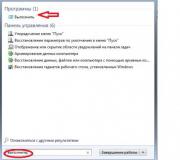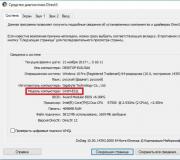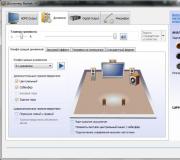How to clean up drive C: detailed instructions
Computers are so ingrained in our lives that it is simply impossible to imagine a world without them. Despite this, many users do not know how to care for their “iron horse”. For example, not everyone knows how to clean up drive C. This article will help fill the gap in knowledge.
Filling the system disk can lead to a number of inconveniences. If there is little space on drive C, the following problems may occur:
- You cannot install new programs;
- There is no room for operating system updates;
- PC speed decreases.
The first problem is easily solved. If there is not enough space on drive C, then you can install new programs in other partitions (D, E, etc.). But what to do with the second and third points? There is only one way out - you need to clean the system disk. How can this be done? How to free up space on drive C? The answer can be found in this article.
How to free up space on your system disk?
Many people have no idea how to clean up local drive C. People mistakenly believe that it is very difficult. Cleaning your computer is a quick and simple process that does not require any specialized IT knowledge. However, this procedure should not be neglected. The system disk should be cleaned at least once a month.
There are many ways that allow . We will look at the most effective ones in this article. Before we begin, it should be noted that the methods given below can be used to clean up the C drive from junk on Windows 10, Windows 7 and other versions of this OS.
Manually removing unnecessary programs
Of course, software takes up the most space. Therefore, when you need to clean drive C from garbage, first of all you need to pay attention to the software.
How to clean drive C from unnecessary files? To uninstall the program, you need to use the built-in Windows utility. To launch it, you need to go to the “Start” menu and select “Control Panel” in the drop-down tab. Then you need to go to the “Uninstall programs” section.

A new window will open containing information about all the programs that are on the computer. They can be sorted by size, date or name. What can I delete? First of all, software that is not used at all must be uninstalled. As a rule, these are completed games. To remove a program, right-click on it, after which the corresponding tab will appear.
Built-in Windows utility
You can free your computer from garbage using a standard Windows utility. This is done very simply. You need to go to “Computer” and right-click on the disk that we will clean. In the drop-down list, click on the “Properties” item, after which a new window opens with information about the memory partition. We are interested in the “General” tab. Go there and click on the “Disk Cleanup” button.

The built-in utility will begin to analyze the data and look for unnecessary files. This will take a certain amount of time. After the program analyzes the computer's memory, it will produce a list of unnecessary files. They need to be ticked and then click “OK”.

You won’t free up a lot of memory this way, but you can win a couple of tens of megabytes.
Temporary files
To carry out the correct installation or update of programs, antiviruses, etc. Temporary files are created on the computer. The operating system stores them in the Temp folder, which is located on drive C. Temporary files are not needed for the daily operation of programs. Therefore, software that uses intermediate resources deletes them automatically upon completion of installation or update.

However, sometimes a glitch occurs due to which temporary files are not deleted. This leads to the Temp folder gradually becoming clogged and taking up more and more space on the system disk. To fix this, you need to remove the intermediate files manually. This is done very simply. You need to go to the Temp folder, which is located at “Computer” > Drive C > Windows folder. To free up memory on drive C, you need to uninstall the contents of this folder.
![]()
In Windows 10, Windows 7 and other versions of the OS, there are two folders for storing temporary files. You can get to the second one through the Start menu. You just need to enter the search query %Temp%. The folder needs to be opened and cleaned. It is worth noting that sometimes the operating system may issue a warning that some files cannot be deleted. This indicates that they are currently being used by some program. If such a message appears, then simply click the “Skip” button.
"Basket"
“Trash” is a special folder that is a temporary storage for deleted files. Everything stored there takes up computer memory. Therefore, the “Trash” needs to be cleaned from time to time. To do this, you need to right-click on the folder and click on the “Empty Trash” item in the drop-down list. After this, the folder will be freed from garbage, and there will be more memory on drive C.
"Downloads"
Users quite often download movies, music, and games through the standard browser downloader. Files from the Internet are automatically saved to the Downloads folder. And, as you know, it is located on drive C. If a user often downloads some files from the Internet, then the free disk space runs out very quickly. To prevent disk C from becoming clogged, you need to check the boot folder from time to time for the presence of large files. 
You need to open “Computer” and go to “Downloads”.
You need to check the folder for large files and if there are any, they need to be deleted or moved to another drive.
Swap file
In Windows OS there is a paging file. How does it affect memory and why is it needed? Sometimes the system does not have enough RAM to perform certain operations. In such cases, the file takes a certain amount of permanent memory from the disk and uses it as RAM.
To free up drive C, you need to make sure that the paging file takes resources elsewhere. You need to go to the “Computer” folder, and then press RMB. In the tab that appears, click on “Properties”. A window will appear. In it, open “Advanced system settings”.

Then click on “Options”.

In the new window, go to the “Advanced” section and click on “Change”.

We install the disk from which the paging file will take memory. This is done as follows. Select drive C and check the box next to the “No paging file” property. To confirm, click on the “Set” button. With another disk, do the opposite and check the “Size by system choice” property.

If the window does not allow you to change properties (the field with disks is dimly highlighted), then uncheck the box next to the “Automatically select paging file size” option.
Hibernation
To save memory on drive C, you can turn off hibernation on your computer. You need to activate the command line (Win + R combination) and write in it: powercfg.exe –h off. Press Enter and voila – hibernation is disabled. After restarting the computer, you may notice that there is a little more memory on the system disk.

However, it is better not to turn it off unless absolutely necessary. This is an extremely useful feature that allows you to restore previously running programs, even if the computer was turned off. To reactivate hibernation, you need to write the command powercfg.exe –h on in the console and restart the PC.
Checkpoints
Checkpoints are created after various changes in the system (updating drivers, installing new software, etc.). They allow you to roll back the system if any problems arise. But for such an opportunity you need to pay with system memory. To free up drive C, you can delete checkpoints. This will give a couple of megabytes of memory. In this video you can learn how to delete restore points and thus clean up your local drive C:
Conclusion
The memory on drive C gets clogged up pretty quickly. This can cause a whole range of troubles. To avoid problems, you need to monitor the amount of free space and clean the system disk from time to time. Cleaning the C drive has a positive effect on the performance of the computer and does not take much time. There are many free ways to free up disk space when memory is full. Moreover, these methods are the same on all Microsoft operating systems. That is, disk cleanup on Windows 10, Windows 7, Windows XP, Windows Vista is identical.



